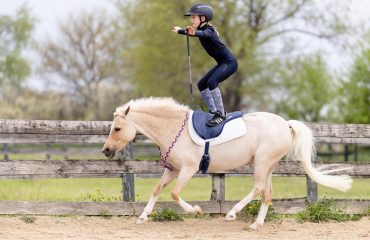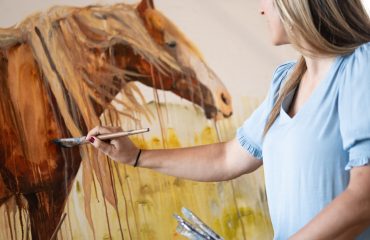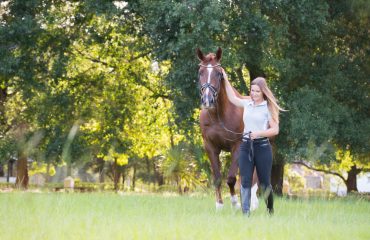By Anna Sochocky
Portraits by Melissa Fuller
Transplanting a teenage hunter-jumper from the hills of Vermont to Germany, where classical dressage reigns supreme, can either be an unwelcome adolescent detour or a chapter that cements the origins of an equestrian career. A self-described military brat, Bill McMullin was used to pulling up stakes and setting his life down in another country. His mother, a committed equestrienne, always managed to ensure that Bill had the opportunity to ride—regardless of on which side of the Atlantic the family lived.
Today, Bill is a USEF “S” dressage judge, a USDF Bronze, Silver and Gold medalist, and an esteemed member of the USDF Instructor/Trainer Program faculty. He was also recently certified as one of only eight USDF instructors at the FEI level. Bill’s professional pyramid highlights all the dressage community’s training, teaching and judging elements.
Developing in Dressage
Bill’s dressage education may have started in Germany, but it fully ignited after his family’s return to the United States. The American dressage community formed his education and professional future. “I trained with several classical instructors from the American Dressage Institute, including Janet Black, Ellen Miller and Michael Mauss, who influenced me in my early years as a rider and teacher,” Bill said. “Later on, as I became involved in the USDF certification program, I had the opportunity to work with others like Lendon Gray, Lilo Fore and Betsy Steiner.”
After returning to the United States, Bill and his mother also bred dressage horses. “One of the horses she and I bred developed to become my first FEI horse and eventually became a schoolmaster that I used to teach my students flying changes, pirouettes and other movements,” he said. “Another horse that we bred also became a schoolmaster in his own right. I took both horses with me as part of a schooling program wherever I went. Both horses lived long into their 30s and enjoyed a long retirement in Vermont under the watchful eye of my parents.”
Yet one phone call Bill made to the celebrated rider and trainer Bill Warren formed the nexus of both his personal life and professional career. “Janet Black helped me extensively with my two horses, but wanted me to get more help and go and work with Bill Warren,” Bill said. “I had known of Bill for several years. We always competed at the same shows. Often, he would be first and I would place second, but we never really met.”
Following that first phone call, Bill got the chance to work with the other Bill. By late September, he moved to Rhode Island and the two Bills formed their training business, Warren-McMullin Dressage, together. The up-and-coming dressage team showcased over 20 horses in training during the first years.
“In our second winter together, we bit the bullet and moved to Florida for our first winter season in 1999. We took seven or eight horses, three of which we owned,” Bill said. “The first years were lean, but we worked to make the business grow. Now, we always have a full barn for the season in Florida, working students and a fully operational training program. We have a smaller group of training horses in New England during the summer, as we are traveling more for clinics and judging.”
Warren-McMullin Dressage also hosts revered clinician Conrad Schumacher at their Massachusetts facility every spring and fall, and at their training site in Florida for an extended stay during the winter months. “The time spent with Conrad has been hugely influential to me not only as a rider, but more importantly as a teacher,” Bill said. “Additionally, over the years, I’ve had the opportunity to work many horses with George Williams. The classical approach that both Conrad and George strictly adhere to coincides with and strengthens our own training values and philosophies.”
Pursuing Excellence
Always looking for avenues to complement his training and teaching, Bill decided the USDF Instructor/Trainer Program was an excellent path to help his budding career and enrolled in the early 1990s. The program, consisting of educational workshops and instructor certification testing, is designed for dressage trainers to further their classical dressage education and be certified by the USDF.
“The USDF Instructor/Trainer Program was so helpful for me in structuring better lessons for riders and learning in much more detail the importance of the Pyramid of Training,” Bill said. “The professional contacts I made starting 30 years ago have been invaluable, and now I also serve as a USDF Instructor/Trainer Program faculty member. I teach the required workshops for instructor candidates in the areas of riding, lunging and teaching.”
Professional accomplishments—and there are many—aside, Bill finds the most reward in teaching his students, whether a skilled rider on a talented FEI horse or a novice rider eager to progress in their own lane. “The nuances and skills learned by a novice rider give me great satisfaction,” he said. “I spend a lot of time with riders at all levels, but especially with more novice riders and amateurs—I really enjoy helping them to develop a better understanding of the first rungs of the training scale.”
Having accomplished the first two aspects of a dressage career—training and teaching—Bill looked ahead to adding a third piece to complement his professional dressage career. “I was interested in becoming a judge and knowing that the training process takes a long time, I started the ‘L’ program around the same time as I began the instructor certification program. I worked through the ‘L’ program, ‘r’ (2nd level), ‘R’ (4th level), and ‘S’ (Grand Prix), and recently became licensed as a senior ‘S’ judge. Most shows want to hire S-level judges, as they can judge every level through Grand Prix,” Bill said.
Bill considers himself fortunate to have been able to partake in the esteemed USDF and USEF judging program through the ‘S’ level. He encourages his students to audit the ‘L’ program even if they aren’t interested in becoming a judge. “The ‘L’ program offers a wealth of knowledge to any student of dressage who wants to gain a better understanding of the Pyramid of Training and the methodology that judges use.”
Bill’s future is, in part, based on his reflections about his dressage life thus far. “The incredible experiences I’ve had with Bill, George Williams and Conrad Schumacher, and other mentors as well as the USDF instructor and judging programs, have shaped me as a teacher,” he said. “I have shown horses through the FEI levels, but I’m not going to the Olympics, and that’s OK with me. After several years of not owning a horse, we purchased a 4-year-old Hanoverian this summer. I’m looking forward to being able to develop this horse and be in the show ring again—and maybe reach Grand Prix with him one day.”
From a Western saddle trotting around a 4-H arena to a top-level dressage rider, trainer, and judge, Bill constructed a professional dressage life predicated upon education, grit and grace.
“I’ve been fortunate to ride so many horses over the years,” he said. “Between Bill and I, we have worked with nearly every breed possible. I think these experiences added so much to my being able to teach, assess a horse and rider in a short time and decide what we need to do.”
Moving up level by level, Bill continues to chart a path for the future of dressage.
For more information, visit warrenmcmullindressage.com
Photos by Melissa Fuller, msfullerphotography.com















